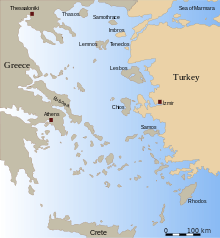Lemnos
| Limnos Λήμνος | |
|---|---|
|
| |
 Limnos | |
|
Location within the region 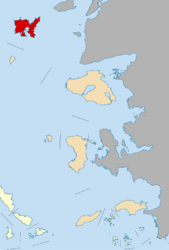 | |
| Coordinates: 39°55′N 25°15′E / 39.917°N 25.250°ECoordinates: 39°55′N 25°15′E / 39.917°N 25.250°E | |
| Country | Greece |
| Administrative region | North Aegean |
| Regional unit | Lemnos |
| Area | |
| • Municipality | 476 km2 (184 sq mi) |
| Highest elevation | 470 m (1,540 ft) |
| Lowest elevation | 0 m (0 ft) |
| Population (2011)[1] | |
| • Municipality | 16,992 |
| • Municipality density | 36/km2 (92/sq mi) |
| Time zone | EET (UTC+2) |
| • Summer (DST) | EEST (UTC+3) |
| Postal code | 81400 |
| Area code(s) | 22540 |
| Vehicle registration | MH, MY |
| Website | www.limnos.gr |
Lemnos (Greek: Λήμνος, Limnos) is an island of Greece in the northern part of the Aegean Sea. Administratively the island forms a separate municipality within the Lemnos regional unit, which is part of the North Aegean region. The principal town of the island and seat of the municipality is Myrina.[2] At 477 square kilometres (184 sq mi), it is the 8th-largest island of Greece.
Geography

Lemnos is mostly flat (hence its more than 30 sand beaches), but the west, and especially the northwest part, is rough and mountainous (highest elevation: Mount Vigla, 470 m). The chief towns are Myrina, on the western coast, and Moudros on the eastern shore of a large bay in the middle of the island. Myrina (also called Kastro, meaning "castle") possesses a good harbour, which is in the process of being upgraded through construction of a west-facing sea wall. It is the seat of all trade carried on with the mainland. The hillsides afford pasture for sheep, and Lemnos has a strong husbandry tradition, being famous for its Kalathaki Limnou[3] (P.D.O.), a cheese made from sheep and goat milk and melipasto cheese, and for its yogurt. Fruit and vegetables that grow on the island include almonds, figs, melons, watermelons, tomatoes, pumpkins and olives. The main crops are wheat, barley, sesame; in fact Lemnos was Constantinople's granary during Byzantine times. Lemnos also produces honey (from thyme-fed bees), but, as is the case with most products of a local nature in Greece, the produced quantities are little more than simply sufficient for the local market. Muscat grapes are grown widely, and are used to produce an unusual table wine that is dry yet has a strong Muscat flavor. Since 1985 the variety and quality of Lemnos wines have increased greatly.
Climate
The climate in Lemnos is mainly Mediterranean.[4] Winters are generally mild, but there will be a snowfall occasionally. Strong winds are a feature of the island, especially in August and in winter time, hence its nickname "the wind-ridden one" (in Greek, Ανεμόεσσα). The temperature is typically 2 to 5 degrees Celsius less than in Athens, especially in summertime.
| Climate data for Limnos Island | |||||||||||||
|---|---|---|---|---|---|---|---|---|---|---|---|---|---|
| Month | Jan | Feb | Mar | Apr | May | Jun | Jul | Aug | Sep | Oct | Nov | Dec | Year |
| Record high °C (°F) | 18.8 (65.8) |
19.0 (66.2) |
22.0 (71.6) |
25.8 (78.4) |
29.8 (85.6) |
34.4 (93.9) |
39.4 (102.9) |
35.8 (96.4) |
32.8 (91) |
31.2 (88.2) |
24.0 (75.2) |
19.2 (66.6) |
39.4 (102.9) |
| Average high °C (°F) | 10.7 (51.3) |
10.9 (51.6) |
12.9 (55.2) |
17.3 (63.1) |
21.9 (71.4) |
26.8 (80.2) |
29.0 (84.2) |
28.2 (82.8) |
25.2 (77.4) |
20.1 (68.2) |
15.3 (59.5) |
12.5 (54.5) |
19.2 (66.6) |
| Daily mean °C (°F) | 7.5 (45.5) |
7.9 (46.2) |
9.9 (49.8) |
13.8 (56.8) |
18.4 (65.1) |
23.3 (73.9) |
25.5 (77.9) |
24.6 (76.3) |
21.4 (70.5) |
16.6 (61.9) |
12.3 (54.1) |
9.3 (48.7) |
15.9 (60.6) |
| Average low °C (°F) | 4.2 (39.6) |
4.7 (40.5) |
6.2 (43.2) |
8.8 (47.8) |
12.8 (55) |
16.8 (62.2) |
19.7 (67.5) |
19.8 (67.6) |
16.4 (61.5) |
12.4 (54.3) |
9.1 (48.4) |
6.1 (43) |
11.4 (52.5) |
| Record low °C (°F) | −5.0 (23) |
−4.2 (24.4) |
−6.0 (21.2) |
1.0 (33.8) |
3.4 (38.1) |
3.4 (38.1) |
12.0 (53.6) |
12.8 (55) |
8.8 (47.8) |
1.6 (34.9) |
−1.0 (30.2) |
−3.6 (25.5) |
−6.0 (21.2) |
| Average precipitation mm (inches) | 72.3 (2.846) |
44.1 (1.736) |
51.6 (2.031) |
32.3 (1.272) |
23.3 (0.917) |
21.9 (0.862) |
10.3 (0.406) |
7.5 (0.295) |
19.6 (0.772) |
35.9 (1.413) |
75.4 (2.969) |
80.2 (3.157) |
474.4 (18.677) |
| Average precipitation days (≥ 1.0 mm) | 7.5 | 6.2 | 5.2 | 4.2 | 3.4 | 2.6 | 1.2 | 1.2 | 1.6 | 3.8 | 7.0 | 8.4 | 52.3 |
| Average relative humidity (%) | 77.0 | 75.4 | 75.9 | 73.4 | 68.8 | 61.0 | 57.6 | 62.5 | 66.8 | 72.8 | 77.9 | 78.6 | 70.6 |
| Source: NOAA[5] | |||||||||||||
Mythic Lemnos
For ancient Greeks, the island was sacred to Hephaestus, god of metallurgy, who—as he tells himself in Iliad I.590ff—fell on Lemnos when Zeus hurled him headlong out of Olympus. There, he was cared for by the Sinties, according to Iliad or by Thetis (Apollodorus, Bibliotheke I:3.5), and there with a Thracian nymph Cabiro (a daughter of Proteus) he fathered a tribe called the Kaberoi. Sacred initiatory rites dedicated to them were performed in the island.
Hephaestus' forge, which was located on Lemnos, as well as the name Aethaleia, sometimes applied to it, points to its volcanic character. It is said that fire occasionally blazed forth from Mosychlos, one of its mountains. The ancient geographer Pausanias relates that a small island called Chryse, off the Lemnian coast, was swallowed up by the sea. All volcanic action is now extinct.
The earliest inhabitants are said to have been a Thracian tribe, whom the Greeks called Sintians, "robbers". The name Lemnos is said by Hecataeus to have been applied in the form of a title to Cybele among the Thracians.[6] The worship of Cybele was characteristic of Thrace, where it had spread from Asia Minor at a very early period. Hypsipyle and Myrina (the name of one of the chief towns) are Amazon names, which are always connected with Asiatic Cybele-worship.
According to the epitome of the Bibliotheke traditionally attributed to Apollodorus (Epitome I:9), when Dionysus found Ariadne abandoned on Naxos, he brought her to Lemnos and there fathered Thoas, Staphylus, Oenopion, and Peparethus. Pliny the Elder in his Natural History (xxxvi. 13) speaks of a remarkable labyrinth in Lemnos, which has not been identified in modern times.
According to a Hellenic legend, the women were all deserted by their husbands for Thracian women, and in revenge they murdered every man on the island. From this barbarous act, the expression Lemnian deeds became proverbial among the Hellenes. According to Apollonius of Rhodes' Argonautica the Argonauts landing soon after found only women in the island, ruled by Hypsipyle, daughter of the old king Thoas. From the Argonauts and the Lemnian women were descended the race called Minyans, whose king Euneus, son of Jason and Hypsipyle, sent wine and provisions to the Achaeans at Troy. According to later Greek historians, the Minyans were expelled by a Pelasgian tribe who came from Attica.
The historical element underlying these traditions is probably that the original Thracian people were gradually brought into communication with the Greeks as navigation began to unite the scattered islands of the Aegean; the Thracian inhabitants were technologically primitive in comparison with the Greek mariners.
In another legend, Philoctetes was left on Lemnos by the Greeks on their way to Troy; and there he suffered ten years' agony from his wounded foot, until Odysseus and Neoptolemus induced him to accompany them to Troy. According to Sophocles, he lived beside Mount Hermaeus, which Aeschylus makes one of the beacon points to flash the news of Troy's downfall home to Argos.
History


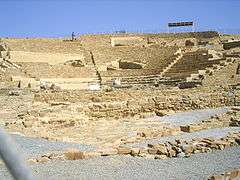
Prehistory
The ruins of the oldest human settlement in the Aegean Islands found so far have been unearthed in archaeological excavations on Lemnos by a team of Greek, Italian and American archaeologists at the Ouriakos site on the Louri coast of Fyssini in Moudros municipality. The excavation began in early June 2009 and the finds brought to light, consisting mainly of high quality stone tools, are from the Epipaleolithic Period, indicating a settlement of hunters and gatherers and fishermen of the 12th millennium BC.
A rectangular building with a double row of stepped seats on the long sides, at the southwest side of the hill of Poliochne, dates back to the Early Bronze Age and was possibly used as a kind of Bouleuterion.
In August and September 1926, members of the Italian School of Archaeology at Athens conducted trial excavations on the island.[7] The overall purpose of the excavations was to shed light on the island's "Etrusco-Pelasgian" civilization. The excavations were conducted on the site of the city of Hephaistia (i. e., Palaiopolis) where the Pelasgians, according to Herodotus, surrendered to Miltiades of Athens. There, a necropolis (ca. 9th–8th centuries BC) was discovered, revealing bronze objects, pots, and over 130 ossuaries. The ossuaries contained distinctly male and female funeral ornaments. Male ossuaries contained knives and axes whereas female ossuaries contained earrings, bronze pins, necklaces, gold-diadems, and bracelets. The decorations on some of the gold objects contained spirals of Mycenaean origin, but had no Geometric forms. According to their ornamentation, the pots discovered at the site were from the Geometric period. However, the pots also preserved spirals indicative of Mycenaean art. The results of the excavations indicate that the Early Iron Age inhabitants of Lemnos could be a remnant of a Mycenaean population and, in addition, the earliest attested reference to Lemnos is the Mycenaean Greek ra-mi-ni-ja, "Lemnian woman", written in Linear B syllabic script.[8] Professor Della Seta reports:[9]
The lack of weapons of bronze, the abundance of weapons of iron, and the type of the pots and the pins gives the impression that the necropolis belongs to the ninth or eighth century B.C. That it did not belong to a Greek population, but to a population which, in the eyes of the Hellenes, appeared barbarous, is shown by the weapons. The Greek weapon, dagger or spear, is lacking: the weapons of the barbarians, the axe and the knife, are common. Since, however, this population … preserves so many elements of Mycenaean art, the Tyrrhenians or Pelasgians of Lemnos may be recognized as a remnant of a Mycenaean population.
Antiquity
Homer speaks as if there were one town in the island called Lemnos. In Classical times there were two towns, Myrina (also called Kastro) and Hephaistia,[10] which was the chief town. Coins from Hephaestia are found in considerable number, and various types including the goddess Athena with her owl, native religious symbols, the caps of the Dioscuri, Apollo, etc. Few coins of Myrina are known. They belong to the period of Attic occupation, and bear Athenian types. A few coins are also known which bear the name of the whole island, rather than of either city.
A trace of the Lemnian language is found on a 6th-century inscription on a funerary stele, the Lemnos stele. Lemnos later adopted the Attic dialect of Athens.
Coming down to a better authenticated period, we find that Lemnos was conquered by Otanes, a general of Darius Hystaspis. But soon (510 BC) it was reconquered by Miltiades the Younger, the tyrant of the Thracian Chersonese. Miltiades later returned to Athens and Lemnos was an Athenian possession until the Macedonian empire absorbed it.
In 197 BC, the Romans declared it free, but in 166 BC gave it over to Athens which retained nominal possession of it until the whole of Greece was made a province of the Roman Republic in 146 BC. After the division of the Roman Empire in 395, Lemnos passed to the Byzantine Empire.
Middle Ages
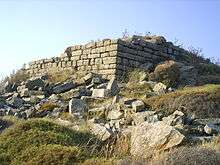
As a province of the Byzantine Empire, Lemnos belonged to the theme of the Aegean Sea, and was a target of Saracen raids.[11] Following the dissolution and division of the Empire after the Fourth Crusade, Lemnos was apportioned to the Latin Empire, and given as a fief to the Navigajoso family under the Venetian (or possibly of mixed Greek and Venetian descent) megadux Filocalo Navigajoso.[12] Filocalo died in 1214, and was succeeded by his son Leonardo and his daughters, who partitioned the island into three fiefs between them. Leonardo retained the title of megadux of the Latin Empire and half the island with the capital, Kastro, while his sisters and their husbands received one quarter each with the fortresses of Moudros and Kotsinos. Leonardo died in 1260 and was succeeded by his son Paolo Navigajoso, who resisted Byzantine attempts at reconquest until his death during a siege of the island by the Byzantine admiral Licario in 1277. Resistance continued by his wife, but in 1278 the Navigajosi were forced to capitulate and cede the island back to Byzantium.
During the last centuries of Byzantium, Lemnos played a prominent role: following the loss of Asia Minor, it was a major source of food, and it played an important role in the recurring civil wars of the 14th century.[11] As the Ottoman threat mounted in the 15th century, possession of Lemnos was demanded by Alfonso V of Aragon in exchange for offering assistance to the beleaguered Byzantines, while the last Byzantine emperor, Constantine XI Palaiologos, offered it to the Genoese captain Giustiniani Longo.[11]
Ottoman period
Following the Fall of Constantinople to the Ottomans in 1453, the island was added to the domain of the Gattilusi of Lesbos.[11] In 1456, the Ottoman Sultan Mehmed II attacked and captured the Gattilusi domains in Thrace (Ainos and the islands of Samothrace and Imbros). During the subsequent negotiations with the lord of Lesbos, Domenico Gattilusio, the Greek populace of Lemnos rose up against Domenico's younger brother Niccolò Gattilusio, and submitted themselves to the Sultan, who appointed a certain Hamza Bey as governor under the Bey of Gallipoli, Isma'il.[13] In 1457, the island was captured by a Papal fleet. Pope Callixtus III hoped to establish a new military order on the island, which controlled the exit of the Dardanelles, but nothing came of it as Isma'il Bey soon recovered Lemnos for the Sultan.[13]
Following the fall of the Despotate of the Morea in 1460, Sultan Mehmed II gave the proceeds from Lemnos to the last Despot, Demetrios Palaiologos.[11] In 1467, during the First Ottoman–Venetian War, Lemnos and other former Gattilusi possessions were seized by the Venetians, but were returned to the Ottomans by the 1479 Treaty of Constantinople.[13] In July 1656, during the Fifth Ottoman–Venetian War, the Venetians captured the island again following a major victory over the Ottoman fleet. The Ottomans under the Kapudan Pasha recovered it barely a year later, on 15 November 1657, after besieging the capital of Kastro for 63 days.[13] In 1770, Kastro was besieged again for 60 days by Count Orlov during the Russo-Turkish War of 1768–1774. The fortress had just surrendered when an attack by the Ottoman fleet on the Russian vessels in Mudros Bay forced the Russians to withdraw (24 October 1770).[13] The famous Sufi poet Niyazi Misri was exiled here for several years during the late 17th century.
Under Ottoman rule, Lemnos initially belonged to the sanjaks of Gallipoli or Mytilene under the Eyalet of the Archipelago, but was constituted as a separate sanjak in the reforms of the mid-19th century, at the latest by 1846. Abolished in 1867, it was re-formed in 1879 and existed until the island's capture by the Greeks in 1912. It comprised the islands of Lemnos (Limni in Turkish), Agios Efstratios (Bozbada), Imbros (Imroz) and Tenedos (Bozcaada).[13][14] The French scholar Vital Cuinet, in his 1896 work La Turquie d'Asie, recorded a population of 27,079, of which 2,450 were Muslims and the rest Greek Orthodox.[13]
Modern period

On 8 October 1912, during the First Balkan War, Lemnos became part of Greece. The Greek navy under Rear Admiral Pavlos Kountouriotis took it over without any casualties from the occupying Turkish Ottoman garrison, who were returned to Anatolia. Peter Charanis, born on the island in 1908 and later a professor of Byzantine history at Rutgers University recounts when the island was occupied and Greek soldiers were sent to the villages and stationed themselves in the public squares. Some of the children ran to see what Greek soldiers looked like. ‘‘What are you looking at?’’ one of them asked. ‘‘At Hellenes,’’ the children replied. ‘‘Are you not Hellenes yourselves?’’ a soldier retorted. ‘‘No, we are Romans." Thus was the most ancient national identity in all of history, preserved in isolation, finally absorbed and ended.[15]
Moudros Bay became a forward anchorage for the Greek fleet, which enabled it to keep watch on the Dardanelles and prevent a foray by the Ottoman Navy into the Aegean. The Ottomans' two attempts to achieve this were beaten back in the battles of Elli and Lemnos. Thus the Ottomans were prevented from supplying and reinforcing their land forces in Macedonia by sea, a critical factor in the success of the Balkan League in the war.
During World War I, the Allies in early 1915 used the island to try to capture the Dardanelles Straits, some 50 kilometres (31 miles) away. This was done chiefly by the British and largely through the enthusiasm of Winston Churchill. The harbour at Moudros was put under the control of British Admiral Rosslyn Wemyss, who was ordered to prepare the then largely unused harbour for operations against the Dardanelles.
The harbour was broad enough for British and French warships, but lacked suitable military facilities, which was recognized early on. Troops intended for Gallipoli had to train in Egypt; and the port found it difficult to cope with casualties of the ill-starred Gallipoli campaign. The campaign was called off in evident failure at the close of 1915. Moudros' importance receded, although it remained the Allied base for the blockade of the Dardanelles during the war. The town of Lemnos, Victoria, Australia, established in 1927 as a soldier settlement zone for returning First World War soldiers, was named after the island.
In late October 1918, the armistice between the Ottoman Empire and the Allies was signed at Moudros.
After the Red Army victory in the Russian Civil War, many Kuban Cossacks fled the country to avoid persecution from the Bolsheviks. A notable evacuation point was the Greek island of Lemnos where 18,000 Kuban Cossacks landed, though many later died of starvation and disease. Most left the island after a year.
Today the island of Lemnos (Limnos) has about 30 villages and settlements. The province includes the island of Agios Efstratios to the southwest which has some exceptional beaches and one of the two deserts in Europe (the other being Błędów Desert in Poland).
Municipality
.jpg)


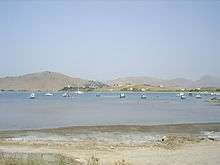

The present municipality of Lemnos was formed on the merger of the following four former municipalities, each of which became municipal units, following the 2011 local government reform:[2]
Lemnos and the smaller island of Agios Efstratios previously formed part of Lesbos Prefecture. In 2011, the prefecture was abolished and Lemnos and Agios Efstratios now form Lemnos Regional Unit. Lemnos Province, abolished in 2006, comprised the same territory as the present regional unit.
Subdivisions
The municipal units of Atsiki, Moudros, Myrina and Nea Koutali are subdivided into the following communities (constituent villages in brackets):
Atsiki
- Agios Dimitrios
- Atsiki (Atsiki, Propouli)
- Dafni
- Karpasi
- Katalakko
- Sardes
- Varos (Varos, Aerolimin)
Moudros
- Fisini (Fisini, Agia Sofia)
- Kalliopi
- Kaminia (Kaminia, Voroskopos)
- Kontopouli (Kontopouli, Agios Alexandros, Agios Theodoros)
- Lychna (Lychna, Anemoessa)
- Moudros (Moudros, Koukonisi)
- Panagia (Panagia, Kortisonas)
- Plaka
- Repanidi (Repanidi, Kotsinos)
- Roussopouli
- Romano
- Skandali
Myrina
- Myrina (Myrina, incl. Androni)
- Thanos (Thanos, Paralia Thanous)
- Kaspakas (Kaspakas, Agios Ioannis, Gali, Limenaria)
- Kornos (Kornos, Psylloi)
- Platy (Platy, Paralia Plateos, Plagisos Molos)
Nea Koutali
- Angariones
- Kallithea
- Kontias
- Livadochori (Livadochori, Poliochni)
- Nea Koutali
- Pedino (Neo Pedino, Palaio Pedino, Vounaria)
- Portianou
- Tsimandria
Socio-economic data
In 2001 the island had 12,116 regular dwellings, of which 65% were stone-built, and 90.2% had pitched roofs made of red tiles (source: 18.3.2001 Census, National Statistical Service of Greece).
The island's economically active population in 2001 was 6,602. Of them, 12% were employers, 20.5% self-employed, 55.3% wage-earners, 7.1% unpaid, auxiliary family members, and 5.1% did not declare line of occupation. Of the economically active population, 17.9% worked in agriculture, 5.3% in light manufacturing, 11% in construction, 6.7% in hotels & restaurants, and the rest in other lines of business (source: 2001 Census, National Statistical Service of Greece).
Transport
The only airport is Lemnos International Airport, 18 kilometres (11 mi) east of Myrina. The island is well served by ferries from Piraeus (Athens), Laurium, Thessaloniki and Kavala.
Notable people
- Alcamenes (5th century BC); sculptor
- Ilias Iliou (1904 – 1985); politician, leader of United Democratic Left
- Rallis Kopsidis (1929 - 2010); painter, writer
- Stelios Roccos (1965), musician, singer
- George Roumeliotis (1964), astrophysicist and data scientist
In popular culture
Lemnos serves as the inspiration for the fictional island nation of "Altis" in the 2013 PC video game ArmA 3 by Czech developers Bohemia Interactive. Despite Altis being scaled down to only 75% of Lemnos' size, and featuring in a storyline set in the 2030s, the layout of the island's landscape, roads and settlements closely resembles that of its real-life counterpart and several of Lemnos' landmarks, such as the fortress at Myrina, the theatre at Hephaistia and the windmills near Kontias, are recreated in the game.
Early in ArmA 3's development, its storyline was to take place on Lemnos itself, but a shift in direction led to the fictionalisation of the setting.[16] The game's depiction of Lemnos led to controversy when two Bohemia Interactive employees were arrested under charges of spying, while holidaying on the island in September 2012.[17] The pair were detained for 129 days before being released on bail.[16]§
A big part of ANZAC Girls (Australian TV Series from 2014) take place in Lemnos, following the story of Australian nurses during the Gallipoli campaign.
See also
- Lemnian language
- Lemniscate
- Armistice of Mudros (or Moudros)
References
- ↑ "Απογραφή Πληθυσμού - Κατοικιών 2011. ΜΟΝΙΜΟΣ Πληθυσμός" (in Greek). Hellenic Statistical Authority.
- 1 2 Kallikratis law Greece Ministry of Interior (Greek)
- ↑ "Recognition of Protected Designation of Origin". World Intellectual Property Organization.
- ↑ Kottek, M.; J. Grieser; C. Beck; B. Rudolf; F. Rubel (2006). "World Map of the Köppen-Geiger climate classification updated" (PDF). Meteorol. Z. 15 (3): 259–263. doi:10.1127/0941-2948/2006/0130. Retrieved January 29, 2013.
- ↑ "Limnos Island Climate Normals 1961-1990". National Oceanic and Atmospheric Administration. Retrieved January 29, 2013.
- ↑ Bryant, Jacob (1807). A New System: Or, An Analysis of Antient Mythology. J. Walker. p. 420. Retrieved 12 August 2016 – via Google Books.
- ↑ A short account of their excavations appeared in the Messager d'Athènes for January 3, 1927.
- ↑ , Word study tool of ancient languages
- ↑ Heffner, Edward H. "Archaeological News: Notes on Recent Archaeological Excavations and Discoveries; Other News" (July–December 1926). American Journal of Archaeology. Vol. 31, No. 1 (January 1927), pp. 99–127, especially pp. 123–124.
- ↑ "Hephaistia". Pleiades, directory of Ancient Places.
- 1 2 3 4 5 Gregory, Timothy E. (1991). "Lemnos". In Kazhdan, Alexander. The Oxford Dictionary of Byzantium. Oxford University Press. p. 1205. ISBN 978-0-19-504652-6.
- ↑ Van Tricht, Filip (2011). The Latin Renovatio of Byzantium: The Empire of Constantinople (1204–1228). Leiden: Brill. pp. 112, 130, 144. ISBN 978-90-04-20323-5.
- 1 2 3 4 5 6 7 Kramers, J. H. (1987). "Limni". In Houtsma, Martijn Theodoor. E.J. Brill's first encyclopaedia of Islam, 1913–1936, Volume V: L–Moriscos. Leiden: BRILL. pp. 27–28. ISBN 90-04-08265-4.
- ↑ Birken, Andreas (1976). Die Provinzen des Osmanischen Reiches. Beihefte zum Tübinger Atlas des Vorderen Orients (in German). 13. Reichert. p. 105. ISBN 9783920153568.
- ↑ Kaldellis, Anthony (2008). Hellenism in Byzantium: The Transformations of Greek Identity and the Reception of the Classical Tradition. Cambridge, UK: Cambridge University Press. ISBN 0521876885. pages 42-43
- 1 2 "Arma 3 renames main island to avoid "undesired real-life connotations"". PC Gamer. February 1, 2013. Retrieved November 6, 2013.
- ↑ "Game makers arrested over alleged spying in Greece". BBC News. September 13, 2012. Retrieved November 6, 2013.
Sources
 This article incorporates text from a publication now in the public domain: Chisholm, Hugh, ed. (1911). "article name needed". Encyclopædia Britannica (11th ed.). Cambridge University Press.
This article incorporates text from a publication now in the public domain: Chisholm, Hugh, ed. (1911). "article name needed". Encyclopædia Britannica (11th ed.). Cambridge University Press.
External links
| Wikimedia Commons has media related to Lemnos. |
 Lemnos travel guide from Wikivoyage
Lemnos travel guide from Wikivoyage- Official website
- Lemnos travel guide website
- Lemnos International Airport "Hephaestus"

